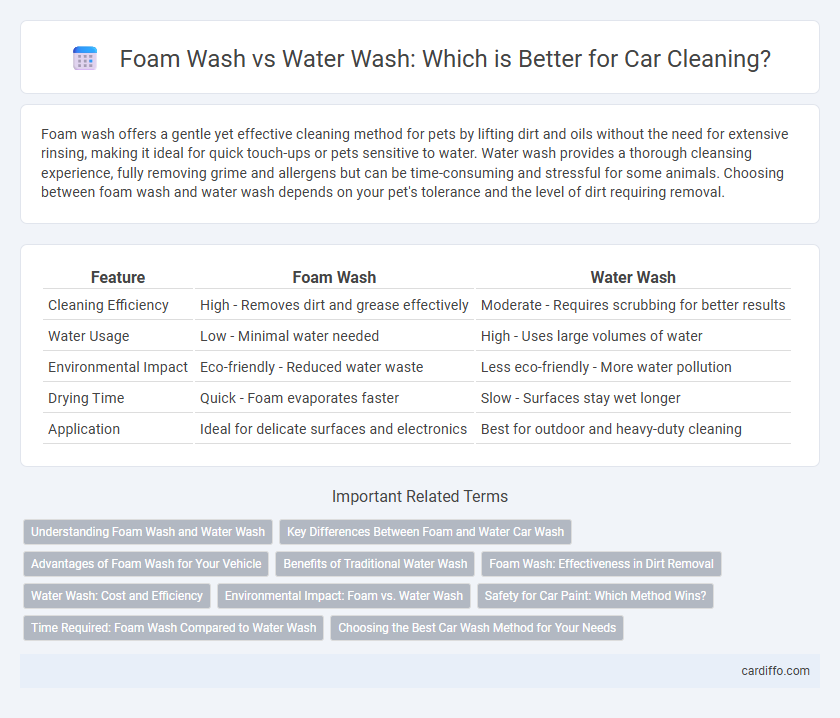Foam wash offers a gentle yet effective cleaning method for pets by lifting dirt and oils without the need for extensive rinsing, making it ideal for quick touch-ups or pets sensitive to water. Water wash provides a thorough cleansing experience, fully removing grime and allergens but can be time-consuming and stressful for some animals. Choosing between foam wash and water wash depends on your pet's tolerance and the level of dirt requiring removal.
Table of Comparison
| Feature | Foam Wash | Water Wash |
|---|---|---|
| Cleaning Efficiency | High - Removes dirt and grease effectively | Moderate - Requires scrubbing for better results |
| Water Usage | Low - Minimal water needed | High - Uses large volumes of water |
| Environmental Impact | Eco-friendly - Reduced water waste | Less eco-friendly - More water pollution |
| Drying Time | Quick - Foam evaporates faster | Slow - Surfaces stay wet longer |
| Application | Ideal for delicate surfaces and electronics | Best for outdoor and heavy-duty cleaning |
Understanding Foam Wash and Water Wash
Foam wash utilizes dense, soapy foam that clings to surfaces longer, enabling more effective dirt and grime removal with less water usage compared to traditional water wash. Water wash relies on high-pressure water jets to rinse and clean, often requiring more water volume but offering quick rinsing and dirt removal. Choosing between foam wash and water wash depends on surface type, environmental considerations, and cleaning efficiency requirements.
Key Differences Between Foam and Water Car Wash
Foam wash uses a thick layer of foam detergent that clings to the vehicle's surface, effectively loosening dirt and grime without abrasive scrubbing, while water wash relies on high-pressure water jets to remove contaminants. Foam wash often requires less water, reducing environmental impact and preventing the spread of dirt particles that can cause scratches. In contrast, water wash can be quicker for removing loose debris but may risk surface damage if dirt is not adequately softened beforehand.
Advantages of Foam Wash for Your Vehicle
Foam wash offers superior cleaning power by clinging to the vehicle's surface longer, effectively breaking down dirt and grime without abrasive scrubbing. It uses less water compared to traditional water wash, making it an eco-friendly option that reduces overall water consumption. The thick foam also minimizes the risk of scratches and swirl marks, preserving the vehicle's paint finish and enhancing long-term aesthetic appeal.
Benefits of Traditional Water Wash
Traditional water wash effectively removes dirt, grease, and residues from various surfaces with minimal environmental impact due to its biodegradable nature. It offers cost efficiency by utilizing readily available resources and requires no special disposal methods. This method also enhances surface longevity by reducing the risk of abrasive damage often caused by foam-based cleaners.
Foam Wash: Effectiveness in Dirt Removal
Foam wash enhances dirt removal by creating a thick, clinging layer that lifts and encapsulates soil particles, improving cleaning efficiency on various surfaces. The microbubbles in foam penetrate crevices and uneven textures more effectively than water wash, leading to deeper cleaning results. This method reduces water usage while maximizing detergent contact, making foam wash both eco-friendly and highly effective in tough grime removal.
Water Wash: Cost and Efficiency
Water wash offers superior cost efficiency compared to foam wash, as it uses readily available water, minimizing expenses related to specialized cleaning agents. The process typically requires less time and labor, increasing overall operational productivity in industrial and commercial applications. Water wash also ensures thorough residue removal, enhancing long-term equipment maintenance and reducing downtime.
Environmental Impact: Foam vs. Water Wash
Foam wash significantly reduces water consumption compared to traditional water wash methods, lowering overall environmental impact by conserving freshwater resources. The concentrated nature of foam detergents allows for effective cleaning with less water runoff and reduced chemical pollution in wastewater systems. Choosing foam wash supports sustainable practices by minimizing resource use and decreasing the carbon footprint associated with water treatment and supply.
Safety for Car Paint: Which Method Wins?
Foam wash offers superior safety for car paint by minimizing direct contact and reducing the risk of scratches compared to traditional water washing. The thick foam layer traps dirt and debris, preventing abrasive particles from damaging the paint surface. Water wash methods often lack this protective barrier, increasing the likelihood of swirl marks and paint degradation over time.
Time Required: Foam Wash Compared to Water Wash
Foam wash significantly reduces cleaning time compared to water wash by targeting dirt and contaminants more efficiently with concentrated surfactants. The foam's thick texture clings to surfaces, allowing prolonged contact time that enhances soil loosening without repeated application, speeding up the overall washing process. In contrast, water wash requires longer scrubbing and rinsing cycles due to its lower cleaning power and quicker runoff.
Choosing the Best Car Wash Method for Your Needs
Foam wash uses thick suds that cling to the car's surface, effectively loosening dirt and grime while minimizing the risk of scratches, making it ideal for delicate paintwork. Water wash relies on high-pressure water jets to remove debris quickly but may cause paint damage or water spots if not properly managed. Selecting the best car wash method depends on your vehicle's condition, paint sensitivity, and desired level of cleanliness, with foam wash offering a gentler, more thorough clean compared to the efficiency of water wash.
foam wash vs water wash Infographic

 cardiffo.com
cardiffo.com